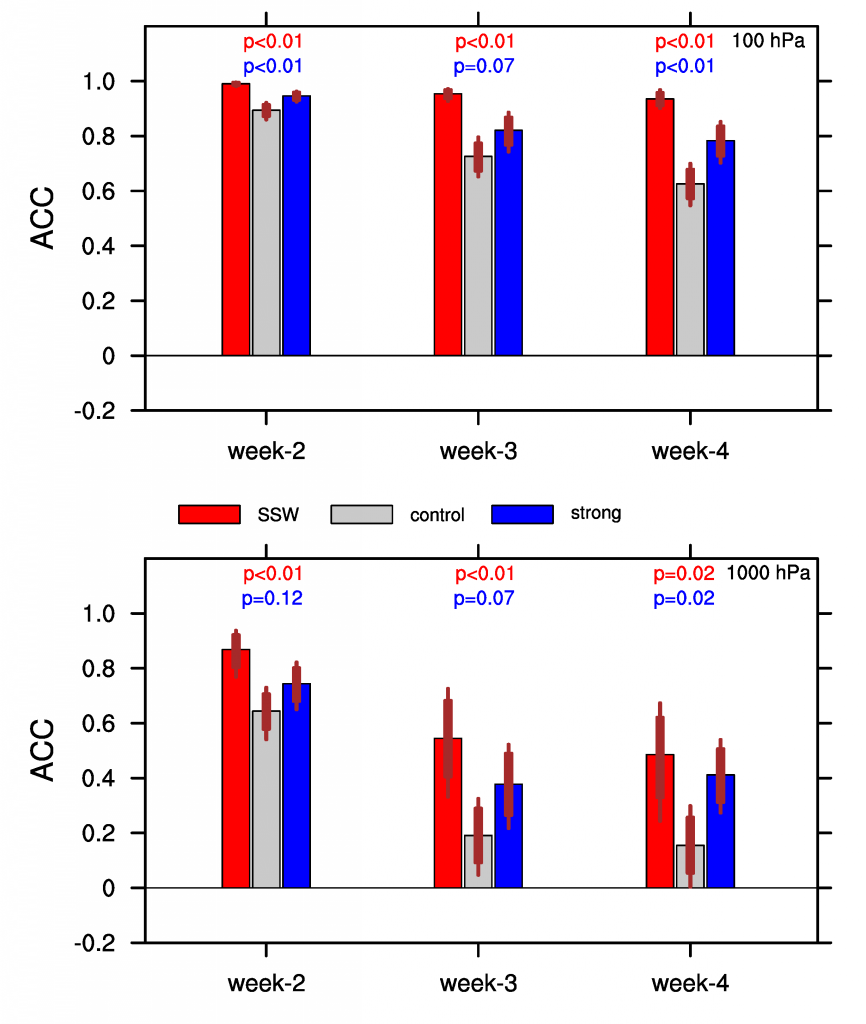This week at the University of Reading is enhancement week and I’ve also been spending some time learning about an area of science which I don’t know so well and which is developing fast at the ECMWF sub-seasonal prediction workshop. Steve Woolnough did a very nice job of introducing sub-seasonal predictability a few weeks ago. The purpose of the workshop is to bring together scientists from universities and operational modelling centres to discuss how successful predictions of the weather on sub-seasonal timescales are, and how models might be improved to do even better in the future. The particular aspect of this that I’m interested in is the role that the stratosphere plays in sub-seasonal predictability and our recent paper shows that there can be a large and significant gain in forecast skill in the troposphere following either a stratospheric sudden warming (SSW) or the onset of very strong winds in the stratosphere. The figure below shows a measure of forecast skill (the anomaly correlation of the Arctic Oscillation index) for three groups of forecasts using the ECMWF model. You can see in weeks 3 and 4 that the forecasts made during SSW and strong vortex conditions result in a more than doubling of forecast skill by this measure.
Figure 1. Weekly forecast skill (ACC) for the NAM index at 100 hPa and at 1000 hPa following the weak vortex (WEAK) and the strong vortex (STRONG) cases. NAM is defined as the mean geopotential height anomaly averaged poleward of 60° N. The thick red bars show the forecast skill when model is initialized on the WEAK dates and the blue bars when the model is initialized on the STRONG dates. The grey bars show the model skills for the MED cases when the vortex is neither very strong nor very weak and is of the medium strength. Thin brown error bars show the 95% confidence level calculated from the bootstrap sampling. The p-values are calculated for the difference in skills between the MED case and WEAK case (red font) and between the MED case and STRONG case (blue font). The p-values indicate the probability that the difference in the skills in WEAK or STRONG cases and MED cases is just by chance and not because of the anomalous stratospheric state at the model initialization time. The skill differences in MED and WEAK (STRONG) cases are significant when the thick error bars are not overlapping and the p-values are less than 0.05 (95% confidence level).
In addition to covering the stratosphere, the workshop has so far discussed the role of the Madden-Julian Oscillation, sea-surface temperature anomalies, variations in soil moisture, snow cover and sea-ice. Although sub-seasonal predictions are now able to demonstrate significant amounts of skill for some variables and regions, it is also clear that there is still a lot of work to be done in understanding how the dynamical links between drivers of sub-seasonal variability occur and on how and why there are ‘windows-of-opportunity’ where more skillful predictions can be made. Later in the week, a significant amount of time will be devoted to group discussions on these drivers of sub-seasonal predictability along with the representation of these processes in models and on international collaborations such as the sub-seasonal to seasonal prediction project, which are designed to enhance our understanding of predictability on the weekly timescale.

